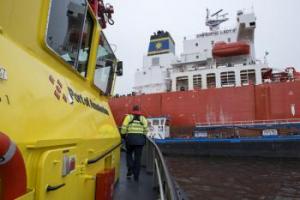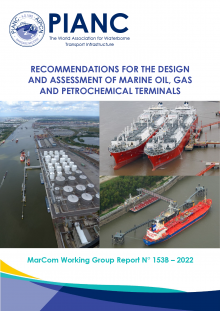Harbour Master
Harbour Masters
Worldwide there are approximately 3,000 merchant ports and the work of the Harbour Master can vary widely from country to country and from port to port even within the same country.


In September 2016, PIANC WG 153 published the document Recommendations for the Design and Assessment of Marine Oil & Petrochemical Terminals.
This document explicitly excluded LNG terminals from the scope since it was believed to add unnecessary complexity to an already-ambitious undertaking. Now that the document is published there is a desire to add LNG terminals to the scope of the document and to make other updates as well.
Most of the content of the document has commonality with LNG terminals, with appropriate language added to address the unique nature of LNG as the cargo. For this reason, it was recommended to add LNG terminals to the 2016 edition rather than publish a separate document solely for LNG terminals. In addition, the vast majority of the WG members also have extensive experience with LNG terminals in addition to oil & petrochemical terminals, so it was efficient to maintain the earlier WG, supplemented by additional expertise as required.
At the end of October PIANC WG 153 announced publication of a revised document Recommendations for the Design and Assessment of Marine Oil, Gas & Petrochemical Terminals. (Pages 358; price €295,00 free to PIANC members).
Background
Marine Oil, Gas, and Petrochemical Terminals (MOGPTs), by the nature of materials being handled, may pose risks to the marine and coastal environment, as well as affect health and safety. Risks include spills, damage to marine life, toxic fumes or vapour clouds, and the possibility of fires and/or explosions. In many cases, these risks are exacerbated by aging infrastructure and components, as well as an inadequate design for the current operations at the terminal. This document provides a set of guidelines and recommendations for the design and assessment of MOGPTs to the global community.
Purpose and Objectives
A principal objective in this publication is to provide guidance as to recommended best practice. It is recommended that any departure from the best practices provided herein be justified and documented, such as through a quantitative risk assessment. On certain topics, a higher standard (HS) of practice is described to clarify and add context to the recommendations, using the nomenclature ‘HS’ in parentheses. The HS designation is used to describe a level of practice that exceeds best practice.
Applicability
These guidelines are applicable to at-shore and nearshore MOGPTs. Quays (wharves), jetties (piers), sea islands, and nearshore single-point and multi-point moorings are examples of the types of terminals that are covered in this document.
Terminals and marine facilities for the following types of terminals are included:
Scope of Document
The guidelines provided in this document focus primarily on the marine terminal infrastructure. Site selection and concept selection are included in the scope of the document. The marine terminal infrastructure includes everything from the ship/shore interface to the foreshore area of the terminal. The ship/shore interface includes both jetties and nearshore floating vessels and their connection to the foreshore area. The foreshore area often includes the control room, electrical power supply and distribution, lighting, pig launcher/receiver, parking, security infrastructure, and related facilities. In addition, the scope of the document includes subsea pipelines, navigation and approach channel, turning basin and manoeuvring and operational areas, which are covered primarily by reference to other established guidance documents on these topics.
Exclusions
Excluded from the scope of this document are the onshore facilities beyond the foreshore, such as the tank farm, onshore pipeline, pumping equipment, and process-related facilities.
The battery limits included in the scope will vary by project and it is recommended that a responsibility matrix be developed for each project to define the responsibilities of each party involved in the design, as well as all the interface points.
To order
Orders may be placed at: https://www.pianc.org/publications/marcom/wg153b
The International Harbour Masters Association (IHMA) and the Port of Rotterdam Authority are pleased to announce the 15th International Harbour Masters Association Congress, to be held from 09–12 June 2026 at Theater Zuidplein in Rotterdam.
Naresh Sewnath, Senior Harbour Master at Transnet National Ports Authority (TNPA) in South Africa’s Port of Durban, began his maritime career back in 1988. He started out as a cadet with TNPA (then known as South African Transport Services (SATS).